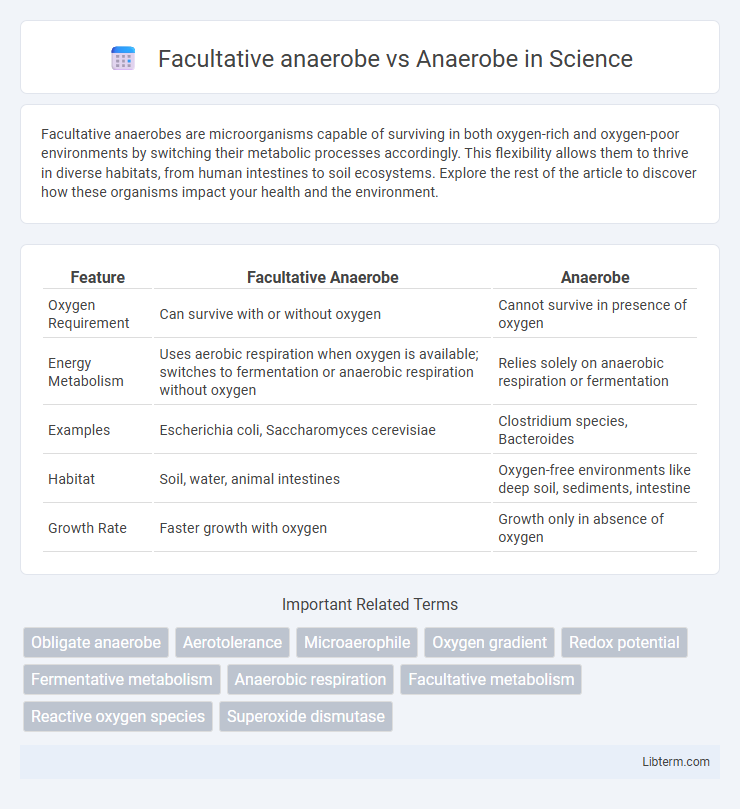Facultative anaerobes are microorganisms capable of surviving in both oxygen-rich and oxygen-poor environments by switching their metabolic processes accordingly. This flexibility allows them to thrive in diverse habitats, from human intestines to soil ecosystems. Explore the rest of the article to discover how these organisms impact your health and the environment.
Table of Comparison
| Feature | Facultative Anaerobe | Anaerobe |
|---|---|---|
| Oxygen Requirement | Can survive with or without oxygen | Cannot survive in presence of oxygen |
| Energy Metabolism | Uses aerobic respiration when oxygen is available; switches to fermentation or anaerobic respiration without oxygen | Relies solely on anaerobic respiration or fermentation |
| Examples | Escherichia coli, Saccharomyces cerevisiae | Clostridium species, Bacteroides |
| Habitat | Soil, water, animal intestines | Oxygen-free environments like deep soil, sediments, intestine |
| Growth Rate | Faster growth with oxygen | Growth only in absence of oxygen |
Introduction to Oxygen Utilization in Microorganisms
Facultative anaerobes can utilize oxygen for aerobic respiration when available but switch to anaerobic metabolism in its absence, enabling metabolic versatility and survival in fluctuating environments. Anaerobes, in contrast, lack the mechanisms to use oxygen and rely solely on anaerobic pathways such as fermentation or anaerobic respiration, often thriving in oxygen-free habitats. Understanding the oxygen utilization strategies in microorganisms highlights their ecological roles and metabolic adaptations to diverse environmental conditions.
Defining Facultative Anaerobes
Facultative anaerobes are microorganisms capable of surviving in both the presence and absence of oxygen by switching between aerobic respiration and anaerobic metabolism. Unlike strict anaerobes, which can only grow in oxygen-free environments due to sensitivity to oxygen, facultative anaerobes utilize oxygen when available for more efficient energy production. This metabolic flexibility allows facultative anaerobes, such as Escherichia coli and Saccharomyces cerevisiae, to adapt to varying environmental oxygen levels.
What Are Obligate Anaerobes?
Obligate anaerobes are microorganisms that cannot survive in the presence of oxygen because it is toxic to them. Unlike facultative anaerobes, which can switch between aerobic and anaerobic metabolism depending on oxygen availability, obligate anaerobes rely exclusively on anaerobic respiration or fermentation for energy production. These organisms are commonly found in oxygen-free environments such as deep soil, sediments, and the human gastrointestinal tract.
Key Differences Between Facultative Anaerobes and Anaerobes
Facultative anaerobes can survive in both the presence and absence of oxygen by switching between aerobic respiration and anaerobic metabolism, whereas strict anaerobes cannot tolerate oxygen and rely solely on anaerobic respiration or fermentation. Facultative anaerobes have enzymes like superoxide dismutase and catalase that protect them from reactive oxygen species, whereas anaerobes typically lack these enzymes, making oxygen toxic to them. The metabolic flexibility of facultative anaerobes enables them to inhabit diverse environments, unlike obligate anaerobes that thrive exclusively in oxygen-free conditions.
Metabolic Pathways: Aerobic vs. Anaerobic Processes
Facultative anaerobes utilize both aerobic respiration and anaerobic fermentation pathways depending on oxygen availability, enabling metabolic flexibility through processes like glycolysis followed by oxidative phosphorylation or fermentation. Anaerobes rely exclusively on anaerobic metabolic pathways such as fermentation or anaerobic respiration using electron acceptors like nitrate or sulfate, bypassing oxygen-dependent reactions entirely. This distinct difference in metabolic pathways influences energy yield, with facultative anaerobes generating more ATP aerobically than anaerobes operating strictly in oxygen-free environments.
Ecological Niches and Environmental Adaptations
Facultative anaerobes thrive in diverse ecological niches by switching between aerobic and anaerobic respiration, enabling survival in fluctuating oxygen levels found in soil, water, and host organisms. Strict anaerobes are adapted to environments completely devoid of oxygen, such as deep sediments, gastrointestinal tracts, and anoxic sediments, relying solely on fermentation or anaerobic respiration. These differing metabolic strategies reflect specialized environmental adaptations, with facultative anaerobes exhibiting metabolic flexibility and anaerobes developing oxygen-sensitive enzyme systems to sustain growth in oxygen-free habitats.
Examples of Facultative Anaerobes and Anaerobes
Facultative anaerobes such as Escherichia coli, Staphylococcus aureus, and Lactobacillus species can survive with or without oxygen by switching between aerobic respiration and fermentation. Anaerobes like Clostridium botulinum, Bacteroides fragilis, and Methanogens thrive exclusively in oxygen-free environments, relying on fermentation or anaerobic respiration for energy. Understanding these examples highlights the metabolic diversity and ecological niches occupied by different bacterial groups.
Clinical Relevance and Health Implications
Facultative anaerobes such as Escherichia coli can survive in both oxygen-rich and oxygen-poor environments, making them versatile pathogens in diverse clinical settings, including urinary tract infections and sepsis. Obligate anaerobes like Clostridium difficile thrive only in oxygen-free environments, often causing severe conditions like pseudomembranous colitis following antibiotic therapy. Understanding the oxygen requirements of these bacteria is crucial for effective infection control, targeted antimicrobial treatment, and managing risks associated with anaerobic infections.
Laboratory Identification and Culturing Techniques
Facultative anaerobes thrive in both the presence and absence of oxygen, allowing growth in oxygen-rich and oxygen-poor environments; they are identified in laboratories using thioglycollate broth, which reveals growth throughout the medium. Strict anaerobes require oxygen-free environments for growth, necessitating culturing techniques that exclude oxygen, such as anaerobic chambers or gas-pack systems. Lab identification of anaerobes often involves the use of selective media and biochemical tests under anaerobic conditions to distinguish them from facultative anaerobes.
Summary: Choosing the Right Organism for the Right Environment
Facultative anaerobes can survive in both oxygen-rich and oxygen-poor environments, making them highly adaptable and ideal for fluctuating conditions that require metabolic flexibility. Anaerobes, which thrive only in the absence of oxygen, are suited for environments such as deep tissues or sediments where oxygen is scarce or absent. Selecting the right organism depends on the environmental oxygen levels, with facultative anaerobes preferred for variable oxygen settings and strict anaerobes chosen for consistently anoxic habitats.
Facultative anaerobe Infographic

 libterm.com
libterm.com